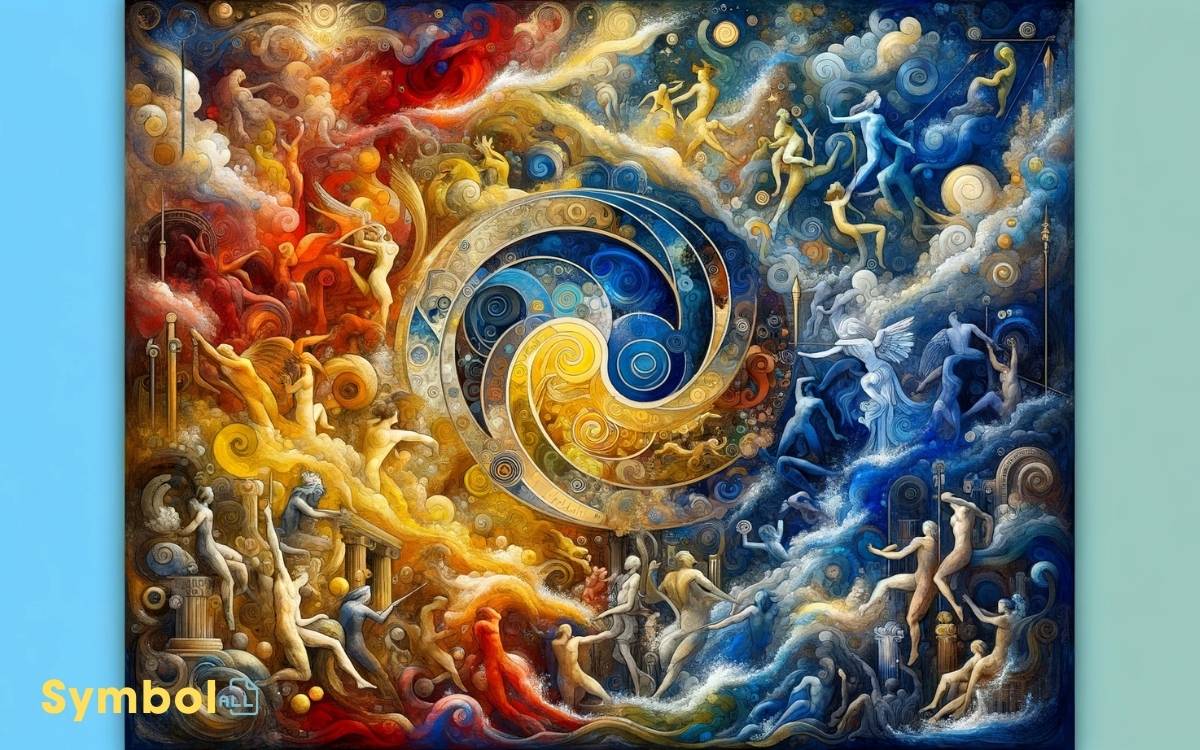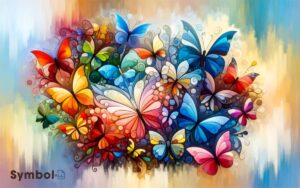Color Symbolism in Greek Mythology: Explains!
In Greek mythology, colors aren’t just hues; they’re powerful symbols. White stands for purity and divine power, guiding you to the transcendent domains.
Blue drapes you in divine protection, while silver, reflecting the moon’s glow, casts spells of magic and transformation.
Venture into the shadows and black reveals the enigmatic kingdom of Hades, a reminder of death’s inevitability. Red, pulsing with passion and war’s ferocity, immerses you in the intensity of divine conflicts.
Each color weaves its own story, offering insights into the ancient ethos. Uncover their tales, and you’ll disclose a tapestry of timeless myths.

Key Takeaways
12 Color Symbolism in Greek Mythology
| Color | Symbolism & Meaning | Associated Deities | Mythological References |
|---|---|---|---|
| White | Purity, birth, innocence, and the divine | Zeus, Hera, Athena | Zeus’s white lightning; Hera’s peacock (white feathers); Athena’s owl |
| Red | War, bloodshed, life force, and sacrifice | Ares, Aphrodite | Ares’s armor; Aphrodite’s rose |
| Black | Death, the Underworld, mystery, and the unknown | Hades, Nyx | Hades’s helm of darkness; Nyx as the personification of night |
| Gold | Wealth, power, and status | Apollo, Artemis | Golden chariot of Apollo; Artemis’s golden bow |
| Blue | The sky, the sea, tranquility, and health | Poseidon, Zeus | Poseidon’s domain over the sea; Zeus, god of the sky |
| Green | Fertility, nature, and rejuvenation | Demeter, Dionysus | Demeter’s association with agriculture; Dionysus’s vine |
| Purple | Royalty, nobility, and authority | Dionysus, Hercules | Dionysus’s robes; Hercules’s royal lineage |
| Silver | Moon, reflection, and clarity of thought | Artemis, Selene | Artemis’s association with the moon; Selene as the moon goddess |
| Bronze | Strength and endurance | Hephaestus, Athena | Hephaestus’s creations; Athena’s Aegis |
| Orange | Endurance, strength, and ambition | Hermes, Atlas | Hermes’s golden sandals; Atlas’s endurance carrying the sky |
| Pink | Love, beauty, and femininity | Aphrodite, Eros | Aphrodite’s charm; Eros’s arrows |
| Yellow | Sunlight, warmth, and happiness | Apollo, Helios | Apollo’s sun chariot; Helios driving the sun |
The Power of White
In Greek mythology, the color white symbolizes purity, divinity, and the transcendent power of the gods, embodying a multifaceted significance that permeates various myths and rituals.
You’ll find that this hue isn’t merely a color; it’s an emblem of celestial connection and moral integrity that the ancients revered.
When you explore into the tales of deities like Zeus and Hera, white often adorns their attire or surroundings, highlighting their supreme status and otherworldly virtues.
It’s not just about the visual appeal; it’s the symbolic weight that white carries, signifying the divine favor and purity of intent that separates mortals from the immortals.
Understanding this aspect offers you a deeper insight into the complex tapestry of Greek mythology, where colors don’t just decorate but narrate the essence of divinity and morality.
Black and the Underworld
You’ll find that in Greek mythology, black embodies the enigmatic essence of Hades’ dark domain, signifying not only the physical depth of the underworld but also its metaphorical depth in the human psyche.
This color’s association with mortality and the afterlife reflects the Greeks’ nuanced understanding of death as a shift rather than an end.
The symbolism woven through these narratives underscores the inevitability of death and the permanence of change, positioning black as an essential element in the tapestry of mythological color symbolism.
Hades Dark Domain
Hades’ dark domain, characterized by the pervasive color black, symbolizes the depth and mystery of the Underworld in Greek mythology. This territory isn’t just a place of death but a symbol of the unknown and the unseen.
Here, black isn’t merely a color; it’s an emblem of the absolute finality and the profound separation from the living world.
- Absence of Light: Black represents the absence of light, mirroring the sunless existence in the Underworld.
- Infinite Depth: The color suggests an unfathomable depth, akin to the endless mysteries hidden in Hades’ territory.
- Barrier: It also serves as a barrier, separating the living from the dead, emphasizing the isolation and finality of death.
Understanding these symbols deepens your appreciation for the complexity and nuance in Greek mythology’s portrayal of the afterlife.
Mortality Symbolism
Exploring further, the color black in the Underworld not only delineates the domain’s boundaries but also profoundly symbolizes mortality, reflecting the human experience with death and the finality it represents.
This symbolism isn’t arbitrary; it’s deeply rooted in ancient Greek perceptions of the afterlife.
Black, enveloping all shades, mirrors the inevitable journey from life to death, a passage every mortal must undertake.
In narratives, this color often marks a character’s confrontation with their mortality or a divine reminder of life’s impermanence. The Greeks didn’t view this merely as an end but as a critical element of the human condition, fostering a nuanced understanding of existence.
Black in the Underworld isn’t just a backdrop; it’s a narrative device, encapsulating the essence of mortality itself, urging introspection on the ephemeral nature of life.
Red: War and Passion
In Greek mythology, red symbolizes both the fervor of passion and the brutality of war, embodying the dual nature of human emotion and conflict.
This color’s significance is deeply ingrained in the narratives of gods and heroes, reflecting their complex relationships and the tumultuous events they navigate. Throughout history, it has been a marker of power, passion, and sacrifice, often serving as a visual cue for the underlying emotions and themes in legendary tales. This enduring resonance is similarly evident in modern storytelling, such as the intricate use of color symbolism in Breaking Bad, where hues are meticulously chosen to mirror characters’ inner conflicts and moral descent. By intertwining color with narrative, creators craft a rich tapestry of meaning that transcends time and culture.
- Ares, the god of war, is often depicted with red attire or armor, highlighting his violent and aggressive nature.
- Aphrodite, the goddess of love and beauty, is associated with red roses, symbolizing deep passion and desire.
- The Furies, avengers of crimes, wear red to represent bloodshed and the relentless pursuit of justice.
Through these associations, red weaves a thread of intensity and dynamism throughout Greek mythology, illustrating the inextricable link between love’s warmth and war’s destruction.
Green: Growth and Rebirth
In Greek mythology, green symbolizes the flourishing vitality of spring and the unending cycle of rebirth, reflecting the ancients’ observation of nature’s rhythms.
You’ll find that green’s connection to fertility isn’t simply literal but also deeply woven into narratives that highlight the earth’s regenerative powers.
This hue’s representation extends from the renewal of flora each spring to the symbolic resurrection of characters and themes within the mythological canon, emphasizing its integral role in depicting nature’s fertility.
Springs Renewal Symbolism
Green, symbolizing growth and rebirth, plays a pivotal role in the narrative of spring’s renewal within Greek mythology. This color not only represents the physical rejuvenation of the earth but also signifies the cyclical nature of life and the promise of new beginnings.
The tales woven around this theme are rich with symbolism and offer deep insights into the ancient Greeks’ understanding of nature and its perpetual regeneration.
- Persephone’s Return: Her ascent from the underworld heralds spring, embodying the earth’s reawakening.
- Demeter’s Joy: The goddess of harvest rejoices, her happiness reflecting the earth’s renewed fertility.
- The Greening of the Earth: Described vividly in myths, it symbolizes hope and the restoration of balance.
Analyzing these elements provides a profound appreciation of how deeply interwoven the natural world and mythology are in Greek culture.
Natures Fertility Representations
Exploring the vibrant tapestry of Greek mythology reveals how green, as a symbol of growth and rebirth, intricately represents nature’s fertility.
This color, embodying the essence of life and renewal, is prominently featured in tales where gods and goddesses interact with the natural world.
Take Demeter, the goddess of agriculture and harvest, often depicted amidst verdant fields, symbolizing her role in ensuring the earth’s fecundity.
Similarly, Dionysus, the god of wine and vegetation, is frequently associated with green, reflecting his connection to vine growth and the cyclical nature of rebirth.
These deities, alongside their narratives, underscore green’s profound significance in embodying nature’s perpetual renewal.
This color’s recurring presence in myths doesn’t merely add aesthetic value but serves as a profound metaphor for life’s resilience and the earth’s endless capacity for regeneration.
Blue: Divine Protection
Throughout Greek mythology, blue often serves as a symbol of divine protection, offering a vivid representation of the gods’ safeguarding powers over their favored mortals and heroes.
This hue isn’t merely a color but a symbol of the celestial and the divine, acting as a protective cloak against misfortune and harm.
- Aegis of Zeus: The shield of Zeus, often depicted as bearing the head of Medusa, is enveloped in a divine blue, signifying the ultimate protection afforded by the king of gods.
- Athena’s Robes: Athena, the goddess of wisdom and warfare, is frequently portrayed wearing blue attire, embodying wisdom’s protective power.
- Poseidon’s Domain: The sea, under Poseidon’s rule, is a vast expanse of blue, representing his protective embrace over sailors and sea creatures.
This color’s protective essence is intricately woven into the fabric of Greek myths, highlighting the gods’ omnipresent safeguarding of their devotees.
The Golden Touch
In Greek mythology, the allure of the Golden Touch reveals the complex interplay between human desire and divine intervention, epitomized by the story of King Midas.
You’ll find that gold, far from being merely a symbol of wealth, embodies a paradoxical narrative of both blessing and curse. King Midas’s wish granted by Dionysus to turn everything he touched into gold serves as a quintessential caution against avarice.
This mythological episode intricately intertwines the desire for material wealth with the dire consequences of unchecked greed.
The golden hue, while symbolizing prosperity, simultaneously warns of the isolation and despair that can accompany the loss of genuine human connections.
As a result, the Golden Touch not only captivates with its shimmer but also imparts profound lessons on the values of moderation and the essence of true wealth.
Purple: Royalty and Wisdom
Purple, often associated with royalty and wisdom, embodies a deep symbolism within Greek mythology that reflects both the divine status of gods and the esteemed virtues of mortals.
This color’s significance isn’t just a matter of aesthetics but a profound representation of power, intelligence, and the divine right to rule.
- Divine Royalty: Purple is frequently worn by gods, signifying their majestic sovereignty and divine authority.
- Mortal Wisdom: Heroes and scholars draped in purple illustrate their high intellect, moral integrity, and philosophical depth.
- Sacred Ceremonies: In rituals, purple denotes a connection to the divine, guiding mortals towards enlightenment and understanding.
Analyzing purple’s role reveals how deeply interwoven color symbolism is with the cultural and religious fabric of ancient Greece, offering insights into their complex society.
Silver: Moon and Magic
Silver, often reflective of the moon and its mystical properties, holds a unique and profound symbolism in Greek mythology, embodying magic, purity, and transformation.
You’ll find that this luminous metal isn’t just a physical substance but a representation of the divine influence of lunar deities, such as Selene, the personification of the moon.
Her chariot, often depicted as silver, traverses the night sky, illustrating the connection between silver and the celestial.
This metal’s association with magic stems from its use in rituals and the belief in its purifying and protective qualities. Silver artifacts, from jewelry to sacred objects, served as conduits for divine energy, highlighting its role in mediating between the mortal and the divine planes.
Through these connections, silver’s symbolism in Greek mythology encompasses a multifaceted spectrum of meanings, from enchantment and clarity to fluidity and reflection, mirroring the moon’s phases and its influence on the earth.
Orange: Endurance and Strength
In Greek mythology, the color orange represents endurance and strength, qualities vividly illustrated through symbols like Hercules’ Nemean Lion cloak.
You’ll find that Athena’s gift of the olive tree, often depicted in hues of orange, embodies resilience and peace, intertwining strength with serenity.
Similarly, Prometheus’ eternal flame, a beacon of undying light, symbolizes the relentless spirit of mankind, showcasing how orange encapsulates both the physical and moral fortitude inherent in these myths.
Hercules Nemean Lion Cloak
Adorned with the Nemean Lion’s cloak, Hercules symbolizes endurance and strength, showcasing how orange hues in Greek mythology often represent these unyielding qualities.
This vibrant coloration isn’t merely aesthetic; it embodies the very essence of Hercules’ character and his Herculean tasks. The orange of the lion’s pelt, a trophy from his first labor, not only signifies the hero’s physical power but also his resilience and relentless spirit.
- Symbol of Protection: The cloak serves as impenetrable armor, emphasizing Hercules’ invincibility.
- Metaphor for Triumph: Wearing the lion’s skin symbolizes Hercules’ victory over seemingly insurmountable challenges.
- Representation of Transformation: The act of donning the lion’s skin marks Hercules’ evolution from a mere mortal to a legendary demigod.
This nuanced use of color enhances the narrative, deepening the symbolism behind Hercules’ legendary feats.
Athenas Olive Tree Gift
Gifted by Athena, the olive tree stands as a robust symbol of endurance and strength, mirroring the orange hues prevalent in Greek mythology that encapsulate these formidable qualities.
This divine offering didn’t merely bestow a resource-rich plant; it represented an immortal connection between the goddess and the city of Athens, symbolizing peace and prosperity.
The olive tree’s resilience, able to grow in rugged conditions and live for centuries, parallels the enduring spirit and unyielding strength of the Greek people.
Here, the color orange emerges not just as a visual element but as a narrative device, weaving a story of survival, growth, and the triumph of life over adversity.
Through Athena’s gift, the olive tree embodies the essence of perseverance, enlightening your understanding of Greek mythological symbolism.
Prometheus Eternal Flame
As you explore the tale of Prometheus, it becomes evident that the eternal flame he bestowed upon humanity not only illuminates the depth of his sacrifice but also symbolizes the enduring strength and resilience mirrored in the color orange within Greek mythology.
- Endurance: The eternal flame, much like the color orange, represents an unyielding spirit. Prometheus’ gift to mankind is a proof of his enduring resilience against the odds.
- Strength: Orange embodies the strength and courage Prometheus exhibited. It’s a visual representation of his defiance and strength in facing Zeus’s wrath.
- Resilience: The flame’s perpetual burning is a symbol of humanity’s resilience, inspired by Prometheus’s own unbreakable spirit, highlighting the ability to overcome adversity.
This analysis underlines the profound symbolism interwoven in Greek myths, where color and narrative converge to reveal deeper truths about the human condition.
Pink: Love and Harmony
In Greek mythology, pink symbolizes love and harmony, reflecting the deep emotional bonds and peaceful unity among gods and mortals. This color consistently appears in myths where affection, beauty, and compassion are central themes.
Its significance is deeply woven into the fabric of various stories, highlighting the importance of these emotions in the divine and the human domains.
| Deity | Association with Pink |
|---|---|
| Aphrodite | Goddess of love and beauty, often depicted with pink elements to signify her influence over love. |
| Eros | Represented with pink to symbolize the tender affection and the irresistible power of love he embodies. |
| Harmonia | As the goddess of harmony, pink reflects her role in ensuring balance and unity. |
| Hebe | Youth and rejuvenation, attributes often celebrated with the energy and purity of pink.
This color’s presence in myths underscores the value placed on love and harmony, illustrating their essential role in the ancient Greek cosmology.
The Spectrum of Fate
Exploring the Greek myths, one encounters a rich tapestry where colors not only depict the physical world but also map the intricate web of fate that gods and mortals are entwined in.
This spectrum of fate is woven with hues that signify different destinies:
- Black symbolizes death and the underworld, a final destination for souls.
- White represents purity and the divine will of the gods, often guiding heroes.
- Red indicates violence and war, pivotal moments that alter the course of fate.
These colors serve not just as mere decoration but as a sophisticated language, conveying the complex relationships and outcomes predetermined by the divine.
Understanding this chromatic symbolism offers a deeper insight into the narratives’ underlying themes, making you appreciate the ancient storytelling craft in a new light.
Conclusion
As you’ve journeyed through the chromatic tapestry of Greek mythology, you’ve seen how colors explore the fates of gods and mortals alike.
White’s purity, black’s chthonic depths, red’s fiery ardor, green’s renewal, blue’s celestial safeguard, silver’s lunar mystique, orange’s resilient vigor, and pink’s tender union—all paint a universe where destiny is dyed in vivid hues.
This palette doesn’t just explore; it delves deep, illustrating the intricate interplay between color and character, emotion, and ethos in a narrative as rich and complex as life itself.






